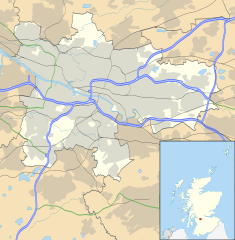The Pollokshaws Burgh Hall is a municipal building at the edge of Pollok Country Park, Glasgow, Scotland. The burgh hall, which was briefly the headquarters of Pollokshaws Burgh Council, is a Category A listed building.[1]
| Pollokshaws Burgh Hall | |
|---|---|
 Pollokshaws Burgh Hall | |
| Location | Glasgow |
| Coordinates | 55°49′31″N 4°17′54″W / 55.8254°N 4.2984°W |
| Built | 1898 |
| Architect | Robert Rowand Anderson |
| Architectural style(s) | Renaissance style |
Listed Building – Category A | |
| Designated | 15 December 1970 |
| Reference no. | LB33953 |
History
editThe building was commissioned and endowed for future maintenance by the politician, Sir John Stirling Maxwell of Pollok House as a gift for the people of Pollokshaws.[2] The site he selected in Pollokshaws Road had formed part of the Old Pollok Estate, which had been home to the Maxwell family for over 700 years.[3]
The burgh hall was designed by Robert Rowand Anderson in the Scottish Renaissance style[2] and was officially opened by Maxwell on 7 December 1898.[4] The design involved an asymmetrical main frontage with four bays facing Pollokshaws Road; the left bay featured a round-headed doorway on the ground floor with a square tower with cupola above of a similar style to the then recently-demolished Glasgow College in the High Street; the right hand three bays contained three windows on the ground floor; there was a large round-headed window on the first floor flanked by two smaller windows and a crow-stepped gable above.[1]
The building was used as the headquarters of the independent burgh of Pollokshaws until the burgh was annexed by Glasgow Corporation in 1912.[2] A war memorial commemorating local people who had died in the First World War was unveiled in front of the burgh hall by the local member of parliament, Sir John Gilmour, on 28 October 1922.[5][6] The hall was used as a British Restaurant during the Second World War.[4]
After functioning as a community centre for Glasgow Corporation and then, from 1975, for Strathclyde Regional Council, it was deemed surplus to requirements in the late 1990s and the management of the building was transferred to the Pollokshaws Burgh Hall Trust in October 2000.[7][8] A Wurlitzer organ with three manuals, which had originally been installed in the Ritz cinema in Stockport and then transferred to Clydebank Town Hall in September 1998, was installed in Pollokshaws Burgh Hall in 2007.[9] The Scottish entertainer, Gordon Cree, who appeared to have developed a special interest in the Wurlitzer, performed on it at a concert in April 2009.[10][11]
Architecture
editThe dominant feature is the tower which is intended to replicate the tower on the old Glasgow College in the High Street.[1]
-
Inside the clock tower
-
The entrance to the hall
-
The war memorial at the hall
-
one of five square carvings on the hall
-
Carving above the rear door
See also
editReferences
edit- ^ a b c Historic Environment Scotland. "Pollokshaws Road and Bengal Street, Pollokshaws Burgh Hall (Category A Listed Building) (LB33953)". Retrieved 19 April 2020.
- ^ a b c "Pollokshaws Burgh Hall". Doors Open Days. Retrieved 19 April 2020.
- ^ "Pollok House: Old Country Houses of the Old Glasgow Gentry (1878)". Glasgow West-end addresses and their occupants. Retrieved 27 September 2020.
- ^ a b "Pollokshaws Heritage Trail". Glasgow City Council. p. 6. Retrieved 19 April 2020.
- ^ "Pollokshaws Burgh Hall". Memorials Online. Retrieved 27 September 2020.
- ^ "Pollokshaws Burgh Hall". Imperial War Museum. Retrieved 19 April 2020.
- ^ "About". Pollokshaws Burgh Hall. Retrieved 19 April 2020.
- ^ "Pollokshaws Burgh Hall". The Glasgow Story. Retrieved 19 April 2020.
- ^ "Pollokshaws, Burgh Hall". The Cinema Organ Society. Retrieved 27 September 2020.
- ^ "Nigel Ogden: The Organist Entertains". BBC. Retrieved 8 April 2012.
- ^ Russell, Ian (17 April 2009). "Darvel entertainer Gordon Cree to appear as guest at Scottish Cinema Organ Trust". Kilmarnock Standard. Kilmarnock, Scotland: Scottish & Universal Newspapers Limited. Retrieved 15 November 2020.
External links
edit- Official site
- Media related to Burgh Hall, Pollokshaws at Wikimedia Commons
